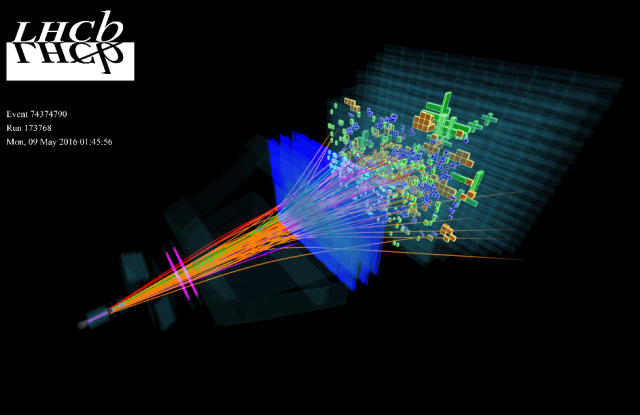LHCb observes an exceptionally large group of particles

The LHCb experiment at CERN is a hotbed of new and outstanding physics results. In just the last few months, the collaboration has announced the measurement of a very rare particle decay and evidence of a new manifestation of matter-antimatter asymmetry, to name just two examples.
In a paper released today, the LHCb collaboration announced the discovery of a new system of five particles all in a single analysis. The exceptionality of this discovery is that observing five new states all at once is a rather unique event.
The particles were found to be excited states 鈥� a particle state that has a higher energy than the absolute minimum configuration (or ground state) 鈥� of a particle called "Omega-c-zero", 惟c0. This 惟c0 is a baryon, a particle with three quarks, containing two "strange" and one "charm" quark. 惟c0 decays via the strong force into another baryon, called "Xi-c-plus", 螢c+ (containing a "charm", a "strange" and an "up" quark) and a kaon K-. Then the 螢c+ particle decays in turn into a proton p, a kaon K- and a pion 蟺+.
From the analysis of the trajectories and the energy left in the detector by all the particles in this final configuration, the LHCb collaboration could trace back the initial event 鈥� the decay of the 惟c0 鈥� and its excited states. These particle states are named, according to the standard convention, 惟c(3000)0, 惟c(3050)0, 惟c(3066)0, 惟c(3090)0 and 惟c(3119)0. The numbers indicate their masses in megaelectronvolts (MeV), as measured by LHCb.
This discovery was made possible thanks to the specialised capabilities of the LHCb detector in the precise recognition of different types of particles and also thanks to the large dataset accumulated during the first and second runs of the Large Hadron Collider. These two ingredients allowed the five excited states to be identified with an overwhelming level of statistical significance 鈥� meaning that the discovery cannot be just a statistical fluke of data.
The next step will be the determination of the quantum numbers of these new particles 鈥� characteristic numbers used to identify the properties of a specific particle 鈥� and the determination of their theoretical significance. This discovery will contribute to understanding how the three constituent quarks are bound inside a baryon and also to probing the correlation between quarks, which plays a key role in describing multi-quark states, such as tetraquarks and pentaquarks.
More information: Observation of five new narrow 惟0/c states decaying to 螢+cK鈭�.
Provided by CERN





















